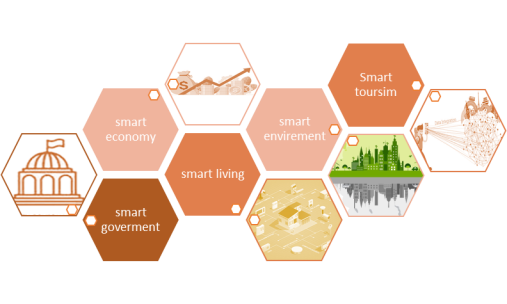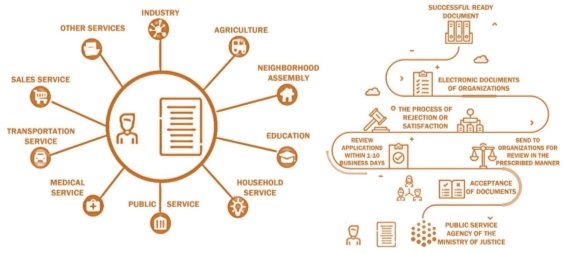As a result of observing the emergence of smart cities in the world, the gradual introduction of such a smart management system in the cities of Central Asia, especially in the new cities of Uzbekistan, is evident in the e-government systems observed in our daily lives. Population growth requires the widespread introduction of new lifestyles, the creation of new cities with many conveniences and cities rich in intellectual, innovative solutions. The history of smart cities in the world today and in the recent past provides information on innovative solutions. Here's a few basic facts about a stomp pad and how it is used. The advantages and disadvantages of different sectors of the economy are presented, as well as new solutions that can bring smart cities to life.
Keywords: innovative city, e-government, electronic control system, Network overconfidence,nanotechnology, smart homes, Songdo House, parametricism, hybrid energy sources, archeology.
The development of science and technology, the rise of modern technologies to a new level, leads to a further improvement of people's lives and lifestyles in society. In recent years, the terms «smart homes» and «smart cities» have been repeated over and over again. While the construction of multi-storey residential buildings in the 70s of the last century, the invention of the elevator due to the large number of floors amazed people, 50 years later, the discoveries made by mankind, the limits of inventions or `q. This leads to the penetration of science and technology in every field in our century, and how many problems in these areas can be easily solved.
It is known that architecture is one of the areas that determines and plans the future stages of development of society, especially in the field of urban planning, which in recent years has undergone significant changes in architecture and urban planning around the world. The construction of very tall skyscrapers, self-powered buildings, transformers, musical fountains, etc., testify to the high level of world architecture.
Smart cities will emerge as a result of the rational placement of such buildings in terms of urban planning and the integration of these facilities into a single structure, the organization of management in connection with a modern system of electronic management and control. This includes engineering communications, ie the provision of clean drinking water, sewerage, electricity, natural gas, heating, waste collection and processing, meeting the daily needs of the population, transport services, A number of areas, such as telephone communication, medical services, will be fully electronic and self-managed using separate programs.
Method:
The history of the ideas or formation of smart cities.
The journey to smart cities dates back to the 1970s, when Los Angeles created the first major city data project: «Cluster Analysis of Los Angeles». The first smart city was undoubtedly Amsterdam, and by 1994, a virtual digital city had been created. The term “smart city” is an idealized city in the United States, in the work environment of two corporations, IBM and CISCO, linked to automation topics.
The concept of smart city is being implemented by megacities around the world — New York, Singapore, Barcelona, Tokyo, Moscow, Amsterdam and dozens of other cities. But the interpretation of this concept can vary from country to country and from organization to organization.
For example, IBM, one of the leading developers of smart city solutions, defines it by three key qualities — equipped, networked, and intelligent. According to the European Parliament, a «smart city» is a city that seeks to solve social problems at the expense of infocommunication resources. Such cities are of strategic importance for combating poverty, inequality and unemployment, and for effective management of energy flows. Russian officials often describe a smart city as an «innovative city» that implements solutions in the best interests of the environment and the population. [2]
Songdo House, as well as the world’s first smart city, Seoul’s smart technology campaigns, only stepped up their initiatives after 2014. On June 25, 2015, the Government of India launched the Smart Cities mission. The goal is to promote sustainable and inclusive cities, providing a clean and sustainable environment and a “smart” program that provides basic infrastructure and a decent quality of life for its citizens. [2]
Discussion:
Benefits of smart cities:
The comprehensive development implemented in the Smart City Concept will help to grow the economy, preserve cultural values, prevent environmental degradation, build cities, create jobs, increase incomes for people and improve the quality of life of its entire population. Some of the advantages of this initiative.
Social benefits:
By providing all services online, it provides public services to citizens, ensuring efficiency, accountability and transparency, thereby making citizen management more convenient and cost-effective;
Provides a sharp reduction in corruption;
Ecological balance is achieved by improving the quality of life of citizens by maintaining and developing open spaces such as eco-parks, extreme foothills, playgrounds and other recreational areas.
It will be an important factor in accelerating the decorbanization. The term decarbonization literally means carbon reduction. The transition to an economic system that sustainably reduces and covers carbon dioxide (CO₂) emissions is clearly envisaged. The long-term goal is to create a global economy without CO.
Economic advantages:
It is easier to solve important problems such as attracting investment;
Ensure that leisure and business trips are targeted, as cities are planned to be identified based on their main economic activities, local cuisine, cafes, restaurants, arts and culture, and more;
Increasing demand for construction and building materials and related industries;
Smart cities create employment opportunities in the region.
Analysis:
At present, such devices are being introduced in new Uzbekistan. For example, the use of new types of electronic meters in the supply of electricity and natural gas has begun. In addition, the order of governance of governmental and non-governmental organizations until 2016 has caused a great deal of inconvenience to citizens. Since 2017, the experiment in Namangan region has been “Introduced public services electronically. From 2018 to 9 months of 2021, the total number of services provided by the Public Service Agency reached 34,402,522, and the type of services reached 162, [6] reaching 207 centers across the country.
All this leads to the widespread introduction of such areas as «Smart City» and «Digital Economy». It also ensures that the population lives in strict compliance with the established rules as a result of the use of video cameras that monitor the movement of cars on the streets, monitor the activities of employees in various workplaces, and constantly monitor the protected areas. Daily needs are provided in a convenient way regardless of the distance, for example, a citizen has the opportunity to pay for electricity through a mobile application, regardless of the distance from the place of residence. All of this is evidence that smart cities are slowly entering our lives. The introduction of smart cities has ushered in a new phase in architecture. In some urban planning, there are rules that sharply reject the rules of architecture.
Cities are constantly facing big problems. The main of these problems is the constant growth of the population and their orientation to urban life. As a result, deficiencies in the city’s geographical environment and culture begin to emerge. In particular: congestion management, excessive pollution, resource use, lack of satisfactory physical and social infrastructure, maintaining sustainable sustainable economic growth, urban energy supply, environmental commitments, etc. [5].

Fig. 1. The structure of smart cities
Since the Industrial Revolution, people have been urbanized at an exponential rate. Hundreds of thousands of new homes are being built every day. As of 2018, about 55 % of the world’s population lives in cities. Every week, at least one million new people move to cities around the world. By 2050, the United Nations (UN) expects 6 billion people to live in cities, plus cities will consume about 70 % of the world’s energy. As a result, the pressure on resources and the scale of the problems faced by cities will increase. It is necessary to develop solutions that improve the sustainability of the city, while significantly reducing resource consumption. There is a need for smart, safe and sustainable transformation across the city.
Advantages of management through modern software

Fig. 2. Use of public services by citizens in ordinary cities (a) in smart cities (b)
The necessary schemes for the use of non-governmental and public services by citizens in our country until 2016 and for the use of various services by citizens in the period from 2017 to 2021 are shown (Fig.2).
Findings:
Placement of master plan of urban buildings.
In urban planning, buildings are placed in accordance with the norm SHNQ 2.07.04–06. The maintenance radius of the building under these rules is as follows. Daily services (community center, shop, teahouse, barber shop, repair and sewing of clothes and shoes, pharmacy, rooms for recreation and physical activity, etc.). Such facilities may be located within reach of pedestrians and, in very rare cases, within 30 minutes of transport. Phase I service facilities.
In a smart city, it is important to make changes to the rules of placement, such as service radii. Because there are now systems in place to use daily services that include qualities such as delivery, ordering, pre-ordering, it is necessary to change the radii of daily service.
Result:
Disadvantages of smart cities:
– Lack of public awareness and social responsibility;
– Building and maintaining infrastructure is expensive and difficult;
– Requires uninterruptible power supply;
– Security issues in terms of open data;
– Limited privacy: Citizens face difficulties in disclosing their names because officials or the government have access to security cameras and smart systems connected through various cameras. Face recognition and the like can drastically change the concept of personal life or personal space;
– Social surveillance: People who can monitor and centralize data collected using security cameras will have greater power. This could be the government, a private agency, or other agencies. They will have the power to control a citizen’s data and can easily change public opinion;
– Network overconfidence: The citizen of these smart cities relies almost entirely on electronics and networks, which can lose autonomy in decision-making and lead to incompetence;
– Challenge in the pre-sales phase: While there is money, smart technology is still in the commercial phase. These cities will lack technology-related skills and potential;
– Preliminary preparation is required: if city dwellers do not know about the technology, they will not be able to use it. Without education, they find it insignificant for their daily lives and find it difficult to use;
– Network overconfidence: The citizen of these smart cities relies almost entirely on electronics and networks, which can lose autonomy in decision-making and lead to incompetence;
– Challenge in the pre-sales phase: While there is money, smart technology is still in the commercial phase. These cities will lack technology-related skills and potential;
– Preliminary preparation is required: if city dwellers do not know about the technology, they will not be able to use it. Without education, they find it insignificant for their daily lives and find it difficult to use.
Advantages of smart cities:
Good transportation services: A smart city has the potential to dramatically improve the current level of transportation throughout the city. This will improve traffic management, track public transport and provide better information and better service to its citizens at affordable prices.
Safe Communication: A smart city will have the most technological advances, and partnering with the private sector will benefit society as crime will be less. Examples of such technology are state number recognition, connected crime centers, shooting detectors, ambulances and body cameras.
Economic Development Opportunities: Investing in smart cities will increase their regional and global competitiveness, attract new residents, and improve business. As long as the whole city has access to an open data platform, information and other companies will thrive. They can make wise decisions using existing technologies and lead to economic development.
The three most popular methodological approaches to power system modeling are optimization, simulation, and balancing tools or models: [3]
Optimization tools: include optimization of the design of endogenous systems;
Simulation tools: provide simulation of exogenous detected energy systems;
Equilibrium instruments or models: Includes a broader econometric model of society.
Conclusion:
Providing the management system with smart techniques should be considered as a necessity of today. An example of this is the smart technology that is influencing the rapid development of countries. A sharp decline in corruption can be called an important area of economic growth, increasing the income of the population by two or more, a favorable working environment, providing remote work systems in more than two workplaces at the same time. Smart medicine, smart buildings, smart construction, smart services (all household services) in all areas to build smart cities. The environment reduces various emissions: The smart city has thousands of energy-saving buildings that can improve air quality, use renewable energy sources and reduce dependence on non-renewable energy sources. This will help reduce our environmental impact on the environment. More digital capital: People need to use high-speed Internet services at affordable prices and on devices. If they have access to a public Wi-Fi network in the local areas of the city, equal opportunities will be created for all residents. Effective public services: With limited natural resources left to meet people’s needs, smart cities will have the technologies and tools to reduce the use of natural resources and reduce waste of water, electricity and more. without reducing any factor.
References:
- “Planning and organization of the territory of agricultural enterprises” SHNQ 2.07.04–06, “State Committee of the Republic of Uzbekistan for Architecture and Construction (State Architectural Construction)” Tashkent-2006
- “What is a smart city? An urban model or a corporate business plan? “Procedia- social and Behavioral Sciences” 223, 18–20 May 2016, Italy (968–973)
- “A Review of Energy Modeling Tools for Energy Efficiency in Smart Cities” Journal Smart Cities 2021, 4, 1420–1436
- “Smart city”: standards, problems, development prospects. Series «Computer technologies, control, radio electronics» 2019.V.19, No. 3.P. 165–171
- “Smart city concept in the light of the literature review” Journal “Engineering Management in Production and Services” Volume 11 Issue 2 2019. 71–72 index in Scopus
- “Analytics in Smart tourism design”, Concepts and Methods, Zheng Xiang, Daniel R, pages 65–77
- “The formation processes of smart cities” Journal “Central Asian journal of arts and design” Vol:02 issue: 12, 2021
- www.aplustopper.com
- www.davxizmat.uz
- www.dxa.gov.uz







